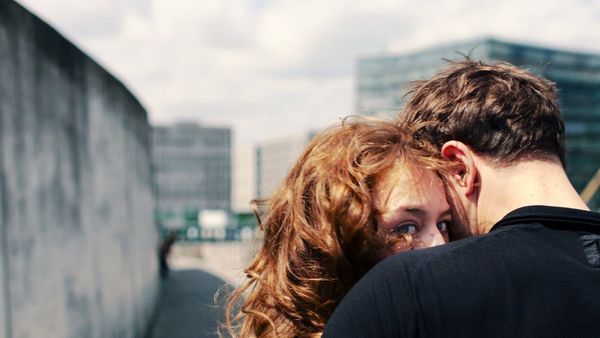Eye For Film >> Movies >> Undine (2020) Film Review
Undine
Reviewed by: Anne-Katrin Titze

Christian Petzold’s Undine (screening virtually in the Main Slate of the New York Film Festival through Wednesday and in London on Monday), starring Paula Beer and Franz Rogowski, is built on the legacy of centuries-old tales and myths. Stories need to change in re-telling in order to remain relevant, otherwise they too will turn to sea foam. Petzold knows how to cast a fishnet into the past and deposit the bounty in the present, as he did in Transit, which featured the same two actors, was based on Anna Seghers's 1944 novel, and set in present-day Marseilles.
“If only thou wouldst send away thy soul, then could I love thee” explains the mermaid in Oscar Wilde’s tale of The Fisherman And His Soul, which was published in the collection A House Of Pomegranates in 1891. The subject of the soul is crucial for a great many Undine narratives. In Friedrich de la Motte Fouqué’s 1811 Romantic novella, water spirit Undine, whose father rules the aquatic realm, lets her live with fishermen because he wishes for her to have a soul. A young knight falls in love with her, and she changes, having gained a soul. But the hearts of men are fickle. Old passions arise in the knight. Should he leave the water spirit, he will have to die. This is the curse of Undine. In Hans Christian Andersen’s Little Mermaid, she cannot stab the beloved and is willing to turn into sea foam. Only the daughters of the air take pity and help her towards gaining an immortal soul.
Berlin is where Petzold’s Undine (Beer) works as a historian giving lectures on urban development in a museum. And more than anything, the question of the soul at stake, is connected to the soul of the city. Berlin, we learn, arose from the swamps - a “dry place in the marsh.” There is no creation myth, no magical starting point and the inhabitants seem to be looking for that lost chronicle, that never was, ever since the water faded. Are the murky origins holding a curse?
The film begins with a breakup in a cafe. Johannes (Jacob Matschenz), smug, conniving and heartless, resembling the abandoned soul/shadow in Wilde’s tale, tells the unsuspecting Undine that their relationship is over. Knowing her mythological baggage, she warns him “if you leave me, I have to kill you.” Fully aware that she has little time and needs to be back at work, Johannes who plotted a smooth good bye, doesn’t seem to be disturbed by her warning that if he didn’t wait for her to return a little later, bad things would happen.
A city planning group awaits her for a tour of the models of the city. There is the one from 1991 of Berlin’s historic Mitte, a GDR model from before ’89 inspiring nostalgia for the former East, one from the Wilhelmine Gründerzeit around 1900, and a tactile one for the visually impaired. When Undine returns to the cafe, the abandoner is gone and a new adventure is about to start.
Industrial diver Christoph (Rogowski) tumbles into Undine’s life in a moment marked by water and blood, shards of glass and flapping fishes. Fittingly, he works in a lake that houses a giant catfish named Big Gunther (Günter Grass, whose 1977 novel The Flounder was inspired by the Grimms’ tale The Fisherman And His Wife, is not the source of the name. Gunther, the very big fish in the reservoir, was named after the Germanic myth Die Nibelungen. The knight Gunther, who raped and killed a young female shepherd, was condemned by a spell to stay in the darkest waters for all times as an ugly, lonely catfish.). The story links are never far once you become aware of them. The man Christoph works for, Jochen (Rafael Stachowiak), is introduced in a shot from the lake from afar. His halfway pulled-down diving suit makes him look like a kraken. Undine is written on something down in the depth of the lake, next to a heart. Christoph’s colleague Monika (Maryam Zaree) clearly has a soft spot for him.
Undine visits Christoph at the lake and they dive together. There is Günter and she swims with him. She is in her element, or is she? Undine is a film of multiple revivals, staying alive is hard work for water folk and the humans they attract. He gives her the figurine of a diver from the aquarium that brought them together in pieces. She has to return to the city to give another lecture. Petzold shows well the bureaucratic nature of her job. She has to wear a uniform of black skirt and white blouse and the presentations to the touring public need to be memorised. There is little room for flourishes. This is not the world of tales, and some of the gaps in storytelling loom large. Albert Speer’s plans and models for Berlin shine in their absence.
Undine has to take over with short notice for a colleague who isn’t going to show up. That night, we see her study the details, facts about the castle destroyed during the war, start of Unter den Linden, the “Prussian Via Triumphalis,” while she sits in her small and crammed apartment in a high-rise. The view from her window above the lights would be grand if the city only looked grander and less generic and dull. There is a very specific ugliness to Berlin that has to do with erasure and fear of its own history. She sees the shiny attempt at inoffensiveness gone awry. The soul has to be elsewhere. The city is suffering from phantom pains.
While she tries to prepare for the next day, Christoph comes to visit. He wants her to give the talk to him now. It reads as a wonderful gesture of love. “You say such clever things; so many; and in such a clever way.” Rogowski’s delivery is funny and touching. Things could not be better for the two of them.
When during a stroll by the Spree river, the past returns and Undine’s heart skips a beat, an ancient plot is yet again set in motion. Jean Cocteau in his Beauty And The Beast used the simple magic trick of film going backward. When Petzold shows the broken mending again, the magic of cinema becomes the subject. It is an eerie power in this enchanted film that seems to deliberately avoid enchanted imagery. The costumes by Katharina Ost (Transit and Jonathan Jakubowicz’s Resistance, starring Jesse Eisenberg as Marcel Marceau) are bland, bordering on unpleasant.
Couples are everywhere in this film, scattered around, they hold hands on a train or run by the protagonists mostly unnoticed. Undine is a love story, or maybe many love stories, and ultimately none of our business. The final shot is from the water. We are in it and say adieu to the world above after having observed these creatures in their entanglements.
And only then did I realise that it wasn’t Undine’s perspective I was close to, nor that of Christoph, but that of another nameless member of the sea-folk, looking at the world in wonder, as an observer from the realm of myth.
Reviewed on: 13 Oct 2020
















